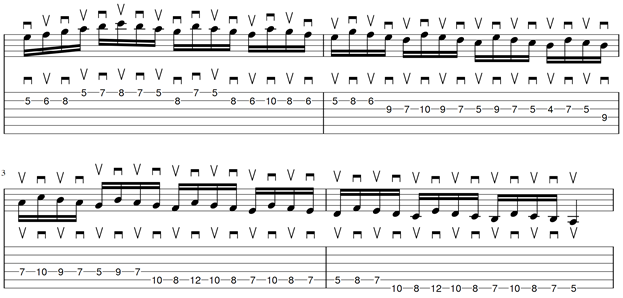The most efficient solution would probably be to play descending fours with UWPS beginning on an upstroke and ascending fours with DWPS beginning with a downstroke, using swiping for the outside string changes in both patterns.
I play both patterns using TWPS, I don’t think I swipe very often. For whatever reason, I’m more comfortable playing both patterns beginning on a downstroke. This might just be down to having spent more time practicing beginning with a downstroke.
I’ve been try to avoid playing straight ascending and descending fours, I think both patterns are cliché. I much prefer the effect of alternating between fours and fives in the Shawn Lane style. I prefer how the lick sounds, and the lick can be played using one-way slanting.
For DWPS, the descending pattern is
|-9-7-6---7-6-------|-------------------|
|-------9-----9-7-6-|-9-7-6---7-6-------|
|-------------------|-------9-----9-7-6-|
|-------------------|-------------------|
|-------------------|-------------------|
|-------------------|-------------------|
u d u d d u d u d u d u d d u d u d (etc)
and the ascending pattern is
|-------------------|-------------------|
|-------------------|-------------------|
|-------------------|-------------------|
|-------------------|-------6-7---6-7-9-|
|-------6-7---6-7-9-|-6-7-9-----9-------|
|-6-7-9-----9-------|-------------------|
u d u d u d d u d u d u d u d d u d (etc)
Both can easily be modified to fit UWPS by switching the order of the four and five, so for UWPS we have the descending pattern
|-9-7-6-----6-------|-------------------|
|-------9-7---9-7-6-|-9-7-6-----6-------|
|-------------------|-------9-7---9-7-6-|
|-------------------|-------------------|
|-------------------|-------------------|
|-------------------|-------------------|
d u d u d u u d u d u d u d u u d u (etc)
and the ascending pattern is
|-------------------|-------------------|
|-------------------|-------------------|
|-------------------|-------------------|
|-------------------|-------6-----6-7-9-|
|-------6-----6-7-9-|-6-7-9---7-9-------|
|-6-7-9---7-9-------|-------------------|
d u d u u d u d u d u d u u d u d u (etc)
I also like Shawn’s approach to descending fours which involves a lot of legato (hammers from nowhere and descending hammers), shown here:
|-9 7 6---7-6-----6-------|-------------------------|
|-------9-----9-7---9-7-6-|-9 7 6---7-6-----6-------|
|-------------------------|-------9-----9-7---9-7-6-|
|-------------------------|-------------------------|
|-------------------------|-------------------------|
|-------------------------|-------------------------|
d u h h d u h h d h h h d u h h d u h h d h h h (etc)
This method displaces the accents, and makes the pattern sound less cliché to me.
@hamsterman, for ascending and descending threes, both can be played easily with swybrid picking (using the pick and middle finger)
Here is the descending pattern
|-9-7-6-7-6---6-----------|-------------------------|
|-----------9---9-7-9-7-6-|-9-7-6-7-6---6-----------|
|-------------------------|-----------9---9-7-9-7-6-|
|-------------------------|-------------------------|
|-------------------------|-------------------------|
|-------------------------|-------------------------|
u d u d u u m d u d u d u d u d u u m d u d u d (etc)
and here is the ascending pattern
|-------------------------|-------------------------|
|-------------------------|-------------------------|
|-------------------------|-------------------------|
|-------------------------|-----------6---6-7-6-7-9-|
|-----------6---6-7-6-7-9-|-6-7-9-7-9---9-----------|
|-6-7-9-7-9---9-----------|-------------------------|
u d u d u m d d u d u d u d u d u m d d u d u d (etc)
Unfortunately, neither ascending or descending fours has a perfect solution with swybrid picking. You could use ascending/descending threes in place of ascending/descending fours, as both are 12 note patterns. Again, this would give the displaced accent sound I like!




